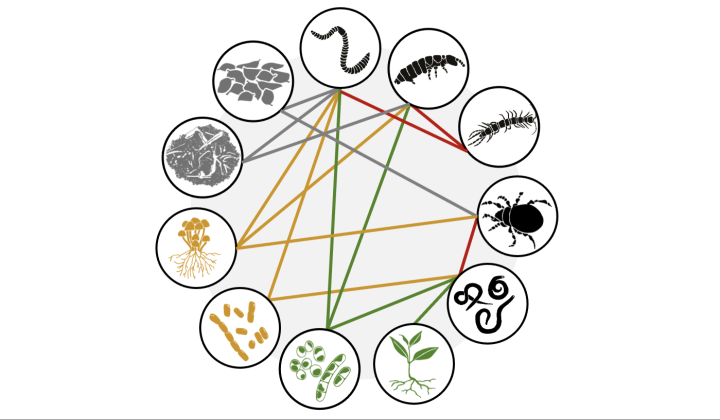Soil Food Webs
Research
In this section we focus on the synthesis research across soil invertebrate taxa. We try to understand, how microorganisms, microfauna, mesofauna and macrofauna interact in food webs and how they affect soil functioning. We work on various levels, from local research and laboratory experiments to EU- and global-scale projects. We combine traditional soil zoological methods with isotopic (13C 15N), biochemical and molecular tools and soil food-web modelling. Below we list our main ongoing projects.
Emmy Noether – Structure of soil food webs and carbon cycling in forests dominated by ecto- and arbuscular mycorrhizal fungi (2022-2028)
Forests dominated by distinct mycorrhizal types differ in their biogeochemistry with larger soil carbon stocks in ectomycorrhizal (EMF) than in arbuscular mycorrhizal fungi (AMF) dominated systems on the global scale. However, soil functioning in these two forest types depends on the local soil context, and the drivers and ecosystem effects of soil invertebrate communities in these systems are poorly explored. In this project, we assess soil food web structure and processes/stocks related to carbon cycling in EMF- and AMF-dominated deciduous forests across Germany and Danemark. Our main objectives are to deliver realistic empirical reconstructions of soil food webs in AMF and EMF forest ecosystems, and describe associations between soil food web structure and ecosystem-level functions, focussing on carbon processing and stabilisation in soil. To achieve this, we combine laboratory experiments, field experiments (stable isotope labelling) and a large-scale observational study. We utilise empirical tools, such as bulk and amino acid stable isotope analyses of soil invertebrates, fatty acid and molecular analyses of soil microbial communities, and soil enzymatic analysis and soil organic matter fractionation.
Soil BON Foodweb – Assessing global drivers and functions of soil animal biodiversity and interactions in soil food webs. (2021-…)
Soil BON Foodweb is a voluntary initiative established in 2021 to assess drivers and functions of soil animal biodiversity and interactions in soil food webs on a global scale. The Soil BON Foodweb Team (SBF Team) is an extension of the Soil Biodiversity Observation Network (Soil BON). We share sampling sites with Soil BON, contribute to joint data analyses, and have similar overarching goals, but focus on soil animal communities across micro-, meso-, and macrofauna. This is truly a ‘community initiative’ that joins soil zoologists and ecologists from 33+ countries around the world. We build a global research network that shares common sampling protocols, experimental projects, and produces long-term essential information on soil animal communities to conserve soil biodiversity and manage the present and future of global soils. In the framework of this initiative, we also develop libraries for AI-based image analysis tools for soil invertebrate community assessment.
https://soilbonfoodweb.org
http://soil-organisms.org/index.php/SO/article/view/178
#GlobalCollembola – Synthesizing global knowledge on springtails (2019-…)
#GlobalCollembola is another distributed-effort initiative aiming at understanding the global distribution of diversity and abundance of Collembola, as well as linking springtail researchers worldwide. In the framework of this initiative, we compiled the largest database on abundance and species diversity of Collembola originating from private archives of researchers around the globe. This is a huge effort, which was possible because many people contributed a piece. We estimated the global biomass of springtails as 27.5 Mt carbon and described latitudinal gradients in their diversity, as well as effects of temperature, precipitation and vegetation types on their communities on the global scale. At present, several research directions are developed in the framework of the initiative, from trait analyses, to outreach.
https://doi.org/10.1038/s41467-023-36216-6
